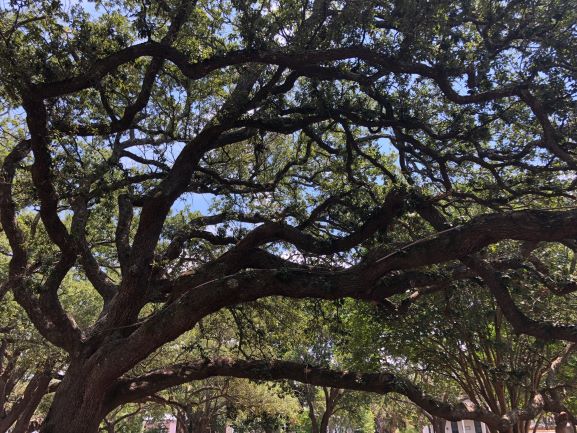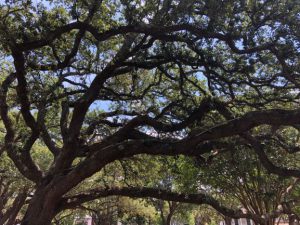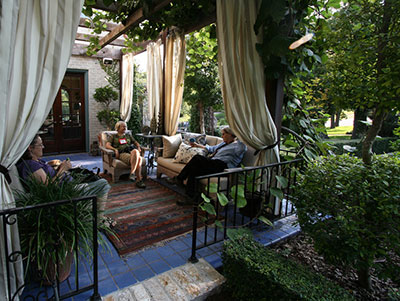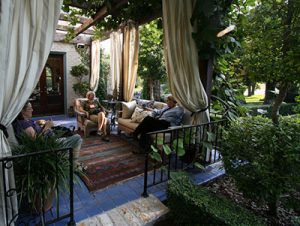
by Carrie Stevenson | Oct 21, 2020

Even healthy live oaks need maintenance and occasional trimming to stay safe. Photo credit: Carrie Stevenson, UF IFAS Extension
After storms, Extension agents are routinely asked about whose responsibility it is to maintain a tree along a property line. This becomes particularly important in a situation where a property owner’s tree or branch falls and causes damage to their neighbor’s home or possessions.
To clarify this often contentious issue, reference to legal experts is necessary. In a series of publications called “The Handbook of Florida Fence and Property Law,” two attorneys and a University of Florida law student explain several statutes that give us direction. The section on “Trees and Landowner Responsibility” goes into further detail and cites case-law, but for ease of reading it is summarized below.
Situation 1: Removing a healthy tree on a shared property line.
If two neighbors share a tree on their property line and one of them wants to remove it, the adjoining landowner must give their permission. Removing trees can impact property value, heating/cooling bills, or aesthetic value. Without a neighbor’s consent, the landowner cutting down a tree can be legally liable for damages.

Hurricanes can have serious impacts on trees in their path. Photo credit: Carrie Stevenson, UF IFAS Extension
Situation 2: Responsibility for overhanging branches and roots.
A big storm hits your neighborhood, with tons of rain, wind, and lightning. You wake up in the morning and see that a large branch fell from your neighbor’s tree and crushed your kids’ basketball goal. If branches from the neighbor’s tree were otherwise healthy, they are not responsible for any damages resulting from the tree. If it was dead, however, and their negligence contributed to the branch falling, they will be responsible for damages.
Keep in mind that if the neighbor’s tree/branches/roots are in good health but interfering with something in your yard, you may trim them at your own expense. The same goes for your tree hanging in their yard, so while it’s not required, it’s always good to have a conversation first to let them know your plans.

After Hurricane Ivan, this tree’s root system completely uprooted and destroyed and adjacent fence. Photo credit: Beth Bolles, UF IFAS Extension
Situation 3: Hurricane Sally blew your neighbor’s tree over and into your yard.
Just like the situation with branches and roots, the same principle goes for an entire tree falling on adjoining property—if the tree was alive, it’s the responsibility of the person whose yard it fell in. If it was dead when it fell, it’s the responsibility of the tree’s owner to pay for damages.
In a complicated situation involving property damage, the saying, “good fences make good neighbors” only goes so far. Be sure to note the health of your trees throughout the year and trim back dead or dying branches. If you see serious decay or have concerns about a tree’s health, contact your county Extension office or a certified arborist. Finally, if the circumstances aren’t easily determined, be sure to contact a licensed attorney and/or your insurance company for direction.

by Stephen Greer | Oct 1, 2020
Living in Northwest Florida brings many wonderful opportunities to be outside enjoying all the things nature has to offer. Outdoor living can become an extension of your home life. Planning and placing a creatively planned landscape space to be a part of this outdoor living adds so many dimensions for all to enjoy.

Outdoor Living, Courtesy UF / IFAS Gardening Solutions page.
Creating a relaxing space outside of your home needs to take in many considerations before planning begins. These spaces should take into account the creative thoughts of the homeowner. Do you enjoy grilling, sitting quietly to take in the sights and sounds of nature, gardening, hedges and walls for private areas, enjoying shady or sunny spots and many other considerations? Do you most like spending your time outside during the day or evening? Will lighting be needed? How much space do you have? What types of furniture will be selected to create those small sitting spots?
Soil types around your home should be a part of plant selections and include water movement considerations during the design process. The northwest area of Florida ranges from sandy coastal to sandhill sands to clay soils in the northern area of many panhandle counties. It is recommended to take soil samples to determine soil needs prior to placing the first plant into these outdoor spaces. With soil moisture ranging from wet to dry, certain plants perform well in wet sites and others in dry sites. That information should be a part of landscape planning decisions.
How do you envision these enjoyable areas and link to the home design? Flowing from the front entry through the home out to the backyard, you need to keep in mind what you and your family want to see and enjoy. What will it look like as the settings mature and change? Will there be walkways connecting the outdoor rooms. What types of walk materials will be used, stone, gravel, wood, turfgrass or another creative material? Are specific plant settings desired that may include a vegetable, flower or herb garden?
Mitigating the influence of insect pests needs to be a consideration when creating an outdoor living space in the panhandle.
Building a fire wise landscape is an important consideration also as the risk of wildfire in the state is always present during drought periods. Selection of plants that are fire resistant should be a priority. Enjoying time with family around the firepit is a pleasant experience. Keep in mind to plan, place and use firepits wisely. Have a firepit safety plan ready.
Outdoor living spaces also include recreation areas, both on and off your property. We are fortunate to have bike friendly roadways, especially in quiet neighborhoods. When biking, always follow the rules and regulations of the road. While out enjoying your pedaling adventure, you may want to take along the fishing equipment. If these are part of your plans think about storing supplies in locations with easy access.
There are a lot of questions that will need to be addressed before outdoor living spaces are created. One important consideration: outdoor spaces should be a comfortable place to visit and may be a quiet place for contemplation or a fun setting for friends and family. Thought should be given to hiring a professional landscape company to assist in making these wonderful settings a reality. Enjoy your outdoor living space!






